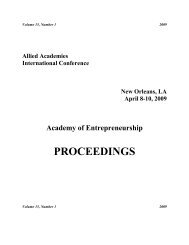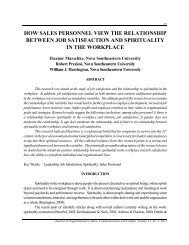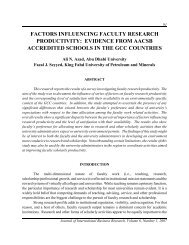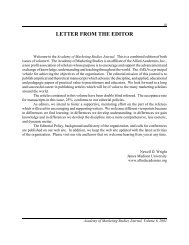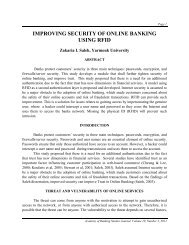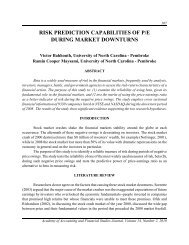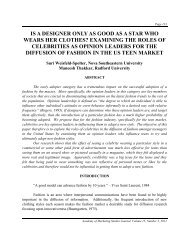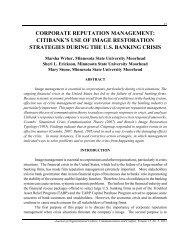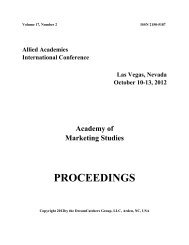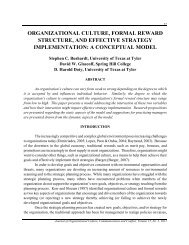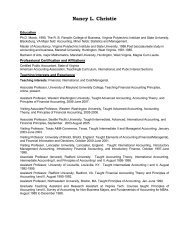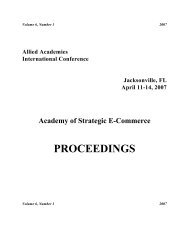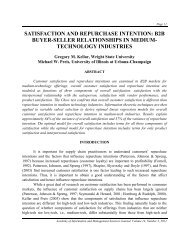liquiditiy and financial leverage ratios - Allied Academies
liquiditiy and financial leverage ratios - Allied Academies
liquiditiy and financial leverage ratios - Allied Academies
You also want an ePaper? Increase the reach of your titles
YUMPU automatically turns print PDFs into web optimized ePapers that Google loves.
Page 135<br />
LIQUIDITIY AND FINANCIAL LEVERAGE RATIOS:<br />
THEIR IMPACT ON COMPLIANCE WITH<br />
INTERNATIONAL FINANCIAL REPORTING<br />
STANDARDS (IFRS)<br />
Rodiel C. Ferrer, De La Salle – Manila, Philippines<br />
Glenda J. Ferrer, University of Rizal System, Philippines<br />
ABSTRACT<br />
This paper investigates how the liquidity <strong>and</strong> <strong>leverage</strong> <strong>ratios</strong> exert significant effect on<br />
the degree of compliance with International Financial Reporting St<strong>and</strong>ard disclosure as<br />
measured by Balance Sheet <strong>and</strong> Income Statement of Publicly Listed Corporations. The<br />
researcher analyzed the effects of current ratio, quick ratio, debt equity ratio <strong>and</strong> interest<br />
coverage ratio on compliance with IFRS. The compliance audit output was used by the author to<br />
calculate the <strong>financial</strong> statement disclosure index using a dichotomous procedure to score each<br />
of the company indices. This study covered 100 publicly listed corporations in the Philippines<br />
from different industries out of the 244 PLCs. The companies belong to different sectors /<br />
industries such as Financials, Industrial, Holding Firms, Property, Services, <strong>and</strong> Mining <strong>and</strong><br />
Oil. Published annual reports of the aforesaid companies have been used as a secondary<br />
source.<br />
Disclosure indices were constructed from 475 items of Balance Sheet disclosure checklist<br />
<strong>and</strong> 263 items of Income Statement disclosure checklist based on the compliance audit consistent<br />
with the International Financial Reporting St<strong>and</strong>ard (IFRS) Report Checklist.<br />
Using multiple regression analysis, the author regressed each of balance sheet index,<br />
income statement index <strong>and</strong> total of income statement – balance sheet indices, against liquidity<br />
<strong>ratios</strong> <strong>and</strong> <strong>financial</strong> <strong>leverage</strong> <strong>ratios</strong> such as current ratio, quick ratio, debt ratio <strong>and</strong> interest<br />
coverage ratio.<br />
Finding suggests that none of the indices exert a significant effect on the <strong>financial</strong><br />
variables cited based on the computed t-statistics whose p-values are greater than the level of<br />
significance (α = 0.05). Therefore, the null hypothesis, that liquidity <strong>and</strong> <strong>financial</strong> <strong>leverage</strong> have<br />
no effect on IFRS when the latter is expressed in terms of Balance Sheet <strong>and</strong> Income Statement<br />
indices, is accepted.<br />
Academy of Accounting <strong>and</strong> Financial Studies Journal, Volume 15, Special Issue Number 1, 2011
The body of this manuscript is not reproduced in this posting. The full text of the manuscript is<br />
available through most university libraries. Should you have difficulty in finding the full text,<br />
you may acquire it from the original journal. Visit http://www.alliedacademies.org to find a link<br />
to the original journal source.
Page 149<br />
<strong>ratios</strong> <strong>and</strong> <strong>financial</strong> <strong>leverage</strong> <strong>ratios</strong> such as current ratio, quick ratio, debt ratio <strong>and</strong> interest<br />
coverage ratio. None of the indices exert a significant effect on the <strong>financial</strong> variables cited<br />
based on the computed t-statistics whose p-values are greater than the level of significance (α =<br />
0.05). Therefore, the null hypothesis, that liquidity <strong>and</strong> <strong>financial</strong> <strong>leverage</strong> have no effect on<br />
IFRS when the latter is expressed in terms of Balance Sheet <strong>and</strong> Income Statement indices, is<br />
accepted.<br />
The OLS assumptions known as multicollinearity, heteroskedasticity, <strong>and</strong> autocorrelation<br />
were utilized. This study noted that the coefficients <strong>and</strong> the mean VIF are less than the critical<br />
value of 10. As such, there is an absence of a linear relationship between the variables. As this<br />
study utilized the cross terms method of the test, this study noted that the White’s Test statistic is<br />
less than the critical chi-square values given the degrees of freedom. Moreover, the p-values<br />
computed are greater than the level of significance that indicates the absence of non-constant<br />
variances among the variables. Thus, this study finds that there is no heteroskedasticity in the<br />
models. The researcher identified the number of changes in the residual <strong>and</strong> treated such<br />
changes as runs. Under this test, the model commits the violation of autocorrelation when the<br />
number of runs fell above the maximum or below the minimum runs as identified by the<br />
allowable range provided by the st<strong>and</strong>ard normal distribution. Using the computations, it can be<br />
observed that the number of runs for all models fall within the maximum <strong>and</strong> minimum runs;<br />
thus providing strong evidence that there is no autocorrelation in our models.<br />
REFERENCES<br />
Bhat, G., O.-K. Hope <strong>and</strong> T. Kang (2006), “Does corporate governance transparency affect the accuracy of analyst<br />
forecasts”, Accounting <strong>and</strong> Finance,(46)5, 715-732.<br />
Cadbury Code, The (1992), Report of the Committee on the Financial Aspects of Corporate Governance: The Code<br />
of Best Practices, December, Gee Professional Publishing, London.<br />
Debrency, R. <strong>and</strong> G.L. Gray (2001). Financial reporting on the Internet <strong>and</strong> the external audit (Abstract). European<br />
Accounting Review, 8:2, 335-350.<br />
Dye, R., <strong>and</strong> S. Sunder (2001). Why Not Allow FASB <strong>and</strong> IASB St<strong>and</strong>ards to Compete in the U.S. Accounting<br />
Horizons 15, 257-272.<br />
Fama, E. F. (1980). Agency problem <strong>and</strong> the theory of the firm. Journal of political economy, 88, 288-308.<br />
Farrar J. <strong>and</strong> B. Hannigan (1998). Farrar’s Company Law, (4 th Edition), Butterworths, London.<br />
Jensen, M. C. (1983). Separation of ownership <strong>and</strong> control. Journal of law <strong>and</strong> economics, 26, 301-325.<br />
Academy of Accounting <strong>and</strong> Financial Studies Journal, Volume 15, Special Issue Number 1, 2011
Page 150<br />
Kusumawati, N. (2006). Profitability <strong>and</strong> corporate governance disclosure: an Indonesian study. Simposium<br />
Nasional Akuntansi 9 Padang.<br />
Lee, H., V. M<strong>and</strong>e, <strong>and</strong> R. Ortman (2004). The effect of audit committee <strong>and</strong> board of director independence on<br />
auditor resignation. Auditing: A journal of practice <strong>and</strong> theory, 23(2)., 131-146.<br />
Leuz, Christian <strong>and</strong> Peter Wysocki (2008). Economic Consequences of Financial Reporting <strong>and</strong> Disclosure<br />
Regulation: A Review <strong>and</strong> Suggestions for Future Research. Retrieved Jan 5, 2010, from<br />
http://ssrn.com/abstract=1105398<br />
Richardson, V. (2000). Information asymmetry <strong>and</strong> earnings management: Some evidence. Review of quantitative<br />
finance <strong>and</strong> accounting, 15, 325-347.<br />
Roberts J. (2004). Agency Theory Ethics <strong>and</strong> Corporate Governance, The Judge Institute of Management<br />
University of Cambridge.<br />
Academy of Accounting <strong>and</strong> Financial Studies Journal, Volume 15, Special Issue Number 1, 2011



